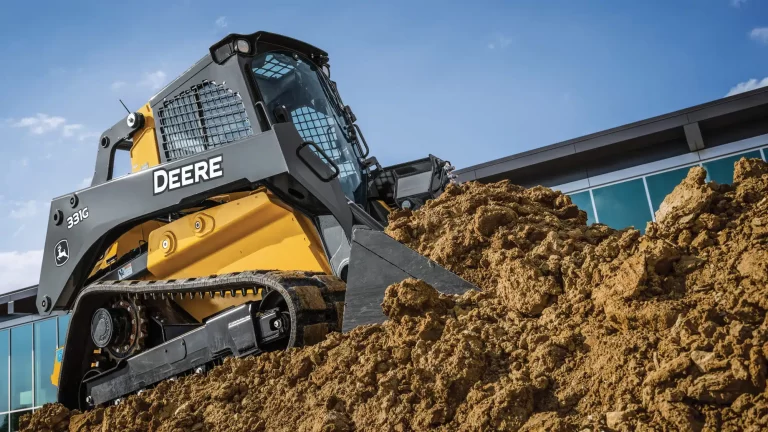Diesel Fuel Filtration: A Practical Guide to Protect Your Gear
Diesel fuel filtration is all about stripping out the bad stuff—water, dirt, rust, and other gunk—before it ever gets near your engine. For any piece of kit running a modern diesel engine, from a compact rock crusher to a mini skid steer, it’s your single most important line of defence against catastrophic injector and fuel pump failures. Put simply, clean fuel isn’t just a nice-to-have; it’s what keeps your machinery on the job and earning its keep.
Why “Clean” Fuel Is a Myth and Filtration Is a Must
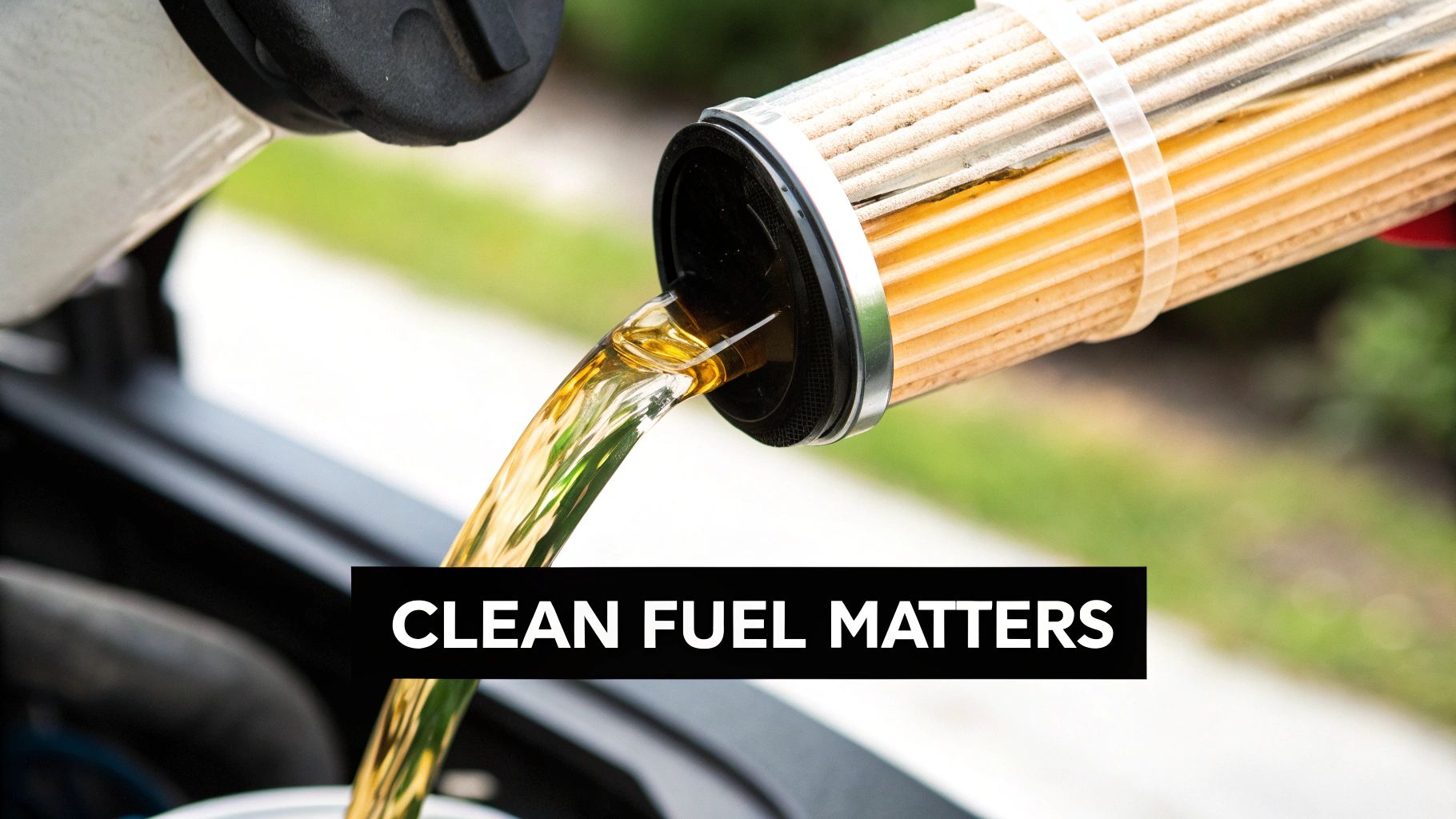
Let’s cut right to the chase. Your equipment is the heart of your operation. Whether you’re running a portable air compressor on a hectic construction site or a tracked site dumper out in the sticks, a machine that’s down is a machine that’s costing you money. That’s precisely why ignoring diesel fuel filtration is one of the most expensive gambles you can take.
You might assume the diesel you pump is clean, but that’s a dangerous assumption. Even fuel that technically meets Australian standards can be loaded with invisible enemies ready to bring your whole operation to a grinding halt.
The Problem With So-Called “Clean” Diesel
Modern high-pressure common rail (HPCR) diesel engines, like the ones you’ll find in today’s mini loaders and compactors, are feats of engineering built to incredibly tight tolerances. We’re talking about injectors that operate under mind-boggling pressure, blasting fuel through openings finer than a human hair. They are incredibly powerful, but also incredibly fragile.
Even a microscopic speck of dirt, a flake of rust from a storage tank, or a tiny droplet of water can wreak havoc. It’s like throwing a bit of sand into a Swiss watch; what starts as a tiny nuisance quickly turns into a full-blown failure. The result? Crippling downtime and a repair bill that will make your eyes water.
The hard truth is that contaminants are everywhere. They find their way into fuel during transport, seep in from underground storage tanks, and even form as condensation inside your machine’s own fuel tank. Think of your tamping rammer sitting out overnight; the temperature drop is enough to make the tank ‘sweat’ on the inside, creating water.
Even with Australia’s fuel standards, the quality can be a real headache for modern engines that were designed to run on cleaner European fuels. This “quality gap” makes top-notch diesel fuel filtration absolutely non-negotiable if you want to protect your investment. You can get more specific insights into how local fuel quality impacts machinery from industry service experts.
Your First and Best Line of Defence
Here’s the thing: good diesel fuel filtration isn’t a luxury. It’s your first, last, and most effective line of defence. Think of a quality filtration system as a dedicated bodyguard for your engine, stopping these damaging contaminants dead in their tracks before they can ever reach the delicate, and expensive, parts of your fuel system.
Investing in a proper filtration setup pays for itself many times over. It means:
- Protecting expensive components: You sidestep premature wear and tear on fuel injectors and pumps, which can easily cost thousands of dollars to replace.
- Slashing costly downtime: A well-maintained machine stays on the job, keeping your projects on track and your business profitable.
- Maintaining peak engine performance: Clean fuel ensures your engine runs just as it should, delivering the power you paid for without sputtering or stalling out.
At the end of the day, for any hard-working machine—from a humble tamping rammer to a tracked mini cement mixer—a robust filtration system is the cheapest insurance you can possibly buy against major engine trouble.
Understanding What’s Contaminating Your Equipment’s Fuel
So, what’s actually lurking inside your diesel tank? It’s easy to assume it’s just fuel, but in reality, a whole host of invisible enemies are trying to sabotage your equipment from the inside out. Getting a handle on these culprits is the first real step toward mastering diesel fuel filtration.
When you break it down, fuel contamination comes from three main troublemakers: water, solid particles, and the dreaded “diesel bug.” Each one attacks your machinery in a different way, but they all lead to the same destination—downtime and hefty repair bills.
The Number One Enemy: Water
Believe it or not, water is the most common and damaging contaminant you’ll face. It doesn’t take a flood or a leaky fuel cap to cause problems; most of the time, water gets into your tank straight from the air.
Picture your tracked site dumper sitting on site after a hot, humid day. As the temperature drops overnight, the warm, moist air inside the half-full fuel tank condenses on the cool tank walls. This “sweat” forms water droplets that sink to the bottom of the tank, right where your fuel pickup is waiting to slurp them up.
It’s a simple process that happens every single day. A bit of condensation might not seem like a big deal, but when that water gets pulled into a high-pressure fuel system, it can flash-steam and blow the tips clean off your injectors. It also causes rust, which just adds more abrasive particles into the mix.
Grit, Dirt, and Rust Particles
Next up is particulate contamination. This is the physical grit—tiny bits of dirt, dust, rust, and metal shavings that manage to find their way into your fuel supply chain.
These particles can sneak in from anywhere:
- Bulk Storage Tanks: Older on-site or supplier tanks can have years of rust and sediment built up at the bottom, just waiting to get pumped into your machinery.
- During Refuelling: Every time you pop the fuel cap on a portable air compressor at a dusty job site, you’re essentially giving dirt an open invitation.
- Internal Wear: As engine components age, they can shed microscopic metal particles directly into the fuel system.
These tiny particles act like liquid sandpaper inside your engine. For the delicate components in a mini loader or concrete cutter, even debris smaller than a human blood cell can score surfaces, block tiny orifices, and lead to catastrophic failure. This is why a powerful cleaning tool is just as vital as clean fuel; keeping your gear spotless on the outside helps stop contaminants from getting inside in the first place. For more on this, check out our guide on the best ways to use diesel pressure cleaners to maintain your equipment.
The “Diesel Bug”: Biological Growth
Finally, we have the nastiest of them all: microbial growth, often called the “diesel bug.” This isn’t a single insect but a cocktail of bacteria, fungi, and algae that can live and multiply right there in your fuel tank.
These microbes thrive at the interface where water and diesel meet. They feed on the diesel and create a thick, black, slimy sludge that can completely choke your fuel filters and lines in no time. If you’ve ever changed a filter on your mini skid steer and found it coated in black gunk, you’ve met the diesel bug firsthand. This sludge starves your engine of fuel, leading to power loss and stalling.
By understanding how these three enemies—water, particles, and microbes—infiltrate your fuel, you can see why a robust diesel fuel filtration system isn’t just an add-on; it’s essential protection for every piece of equipment you own.
How Diesel Fuel Filters Protect Your Engine
Your engine’s fuel system is tough, but it’s definitely not invincible. The best way to think about your diesel fuel filtration system is as a multi-layered security detail, where each component has a specific job: keep the bad stuff out. Without this team, the microscopic grit and water hiding in your diesel would absolutely shred expensive components.
It’s really a tag-team effort between two key players: the primary filter and the secondary filter. Once you understand how they work together, it becomes crystal clear why they’re so crucial for your gear, whether you’re running a mini skid steer or a heavy-duty rock crusher.
The First Line of Defence: The Primary Filter
The first guard at the gate is the primary filter, which you’ll often hear called a fuel water separator or pre-filter. Its job is a bit blunt but absolutely essential—to catch the big problems before they can travel any further down the line. It’s the bouncer for your fuel system.
This filter is designed to do two main things:
- Separate Water: As fuel flows into the separator, its internal design swirls the fuel, causing heavier water droplets to fall out of suspension. These collect in a clear bowl at the bottom, which you can (and should) drain easily.
- Catch Large Debris: It also traps the bigger chunks of rust, dirt, and sludge. This is a huge help because it prevents the more sensitive secondary filter from getting clogged up too quickly with junk.
Think about a portable air compressor running all day on a humid site. That primary filter is working non-stop to pull condensation out of the fuel. Draining that water bowl daily is one of the simplest yet most effective bits of maintenance you can do.
The Final Gatekeeper: The Secondary Filter
Once the fuel gets past the bouncer, it meets the real specialist: the secondary filter. If the primary filter catches boulders, the secondary filter is there to catch the sand. Its whole purpose is to trap the incredibly fine contaminants that are invisible to the naked eye but are absolutely lethal to a modern high-pressure fuel system.
This filter is the last line of defence before fuel enters your engine’s high-pressure pump and injectors. It’s what stands between a smooth-running compactor and a multi-thousand-dollar repair bill.
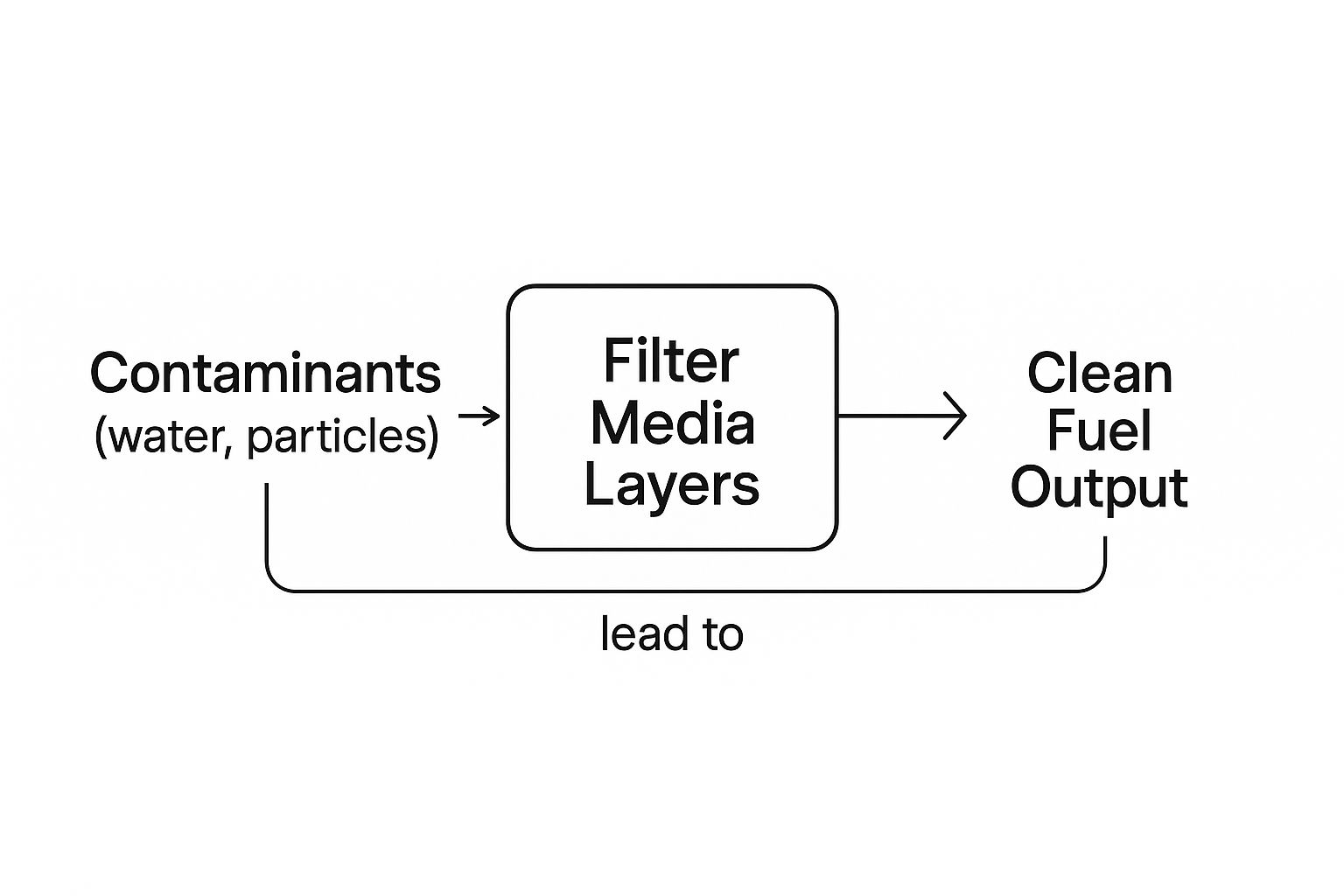
Understanding Micron Ratings
So, how fine is “fine”? This is where the micron rating comes into play. A micron is a unit of measurement—one-millionth of a metre. To put that into perspective, a human hair is about 70 microns thick, while a red blood cell is only about 5 microns.
A filter’s micron rating tells you the size of the particles it’s built to capture. Modern engines in machinery from top brands, like the compaction equipment in the Batmatic range, perfrom best with clean fuel. They often require filtration down to an incredible 2 to 5 microns. This isn’t just a suggestion; it’s a non-negotiable requirement to protect injectors operating at pressures over 30,000 PSI.
But here’s the catch: the micron rating alone isn’t the whole story. You also have to consider the filter’s efficiency. Many standard OEM filters in Australia are rated for this micron range but might only be around 80% efficient. That means 20% of those harmful particles are still getting through, which can cause significant wear and tear over time.
Choosing a filter with the right micron rating and a high efficiency rating is what truly matters. It’s the difference between adequate protection and providing a rock-solid defence for the heart of your machine.
Choosing the Right Filters for Your Machinery
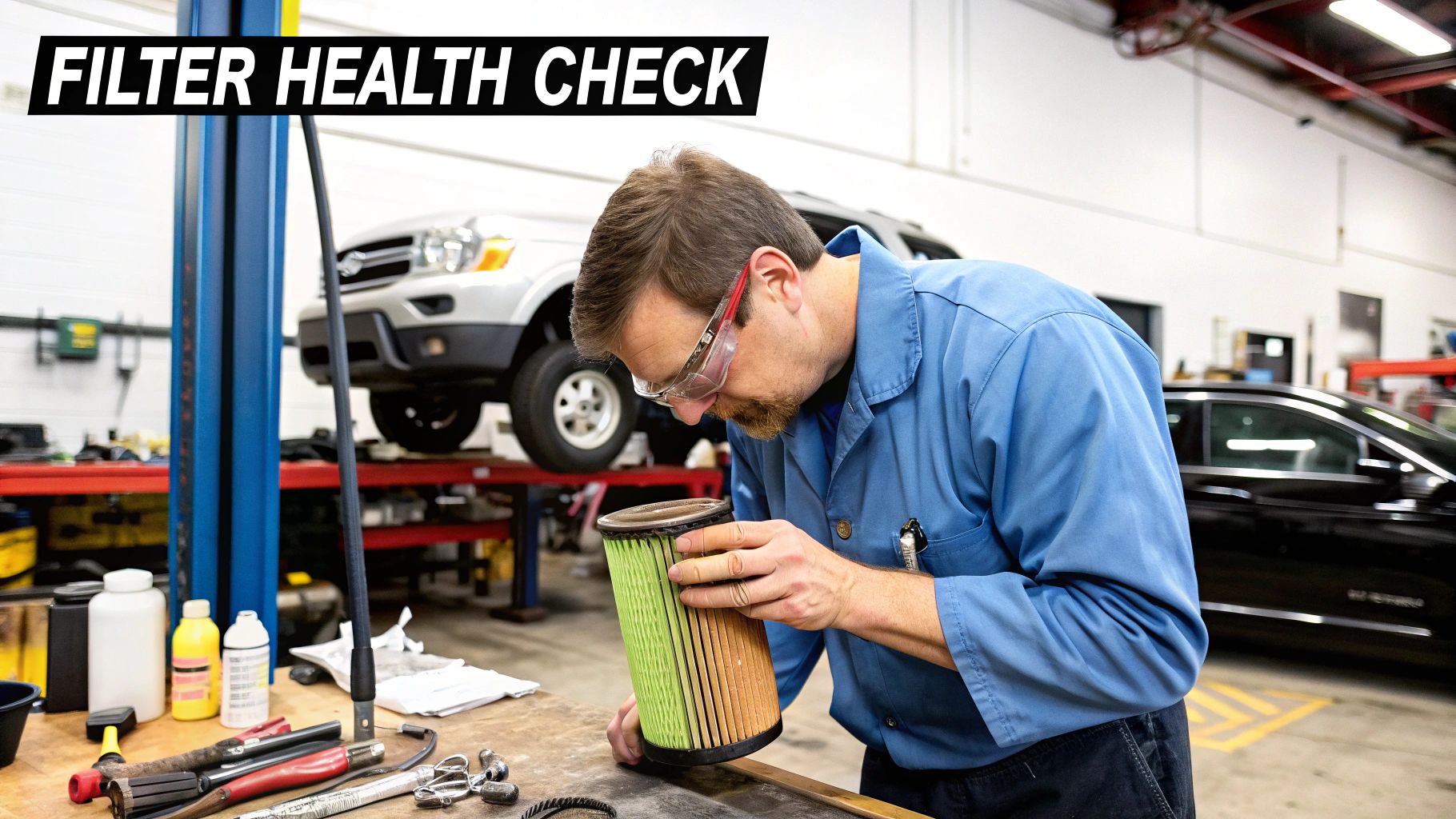
It’s easy to think all fuel filters are basically the same. When you walk into a parts store and see shelves lined with them, it’s tempting to just grab one that fits. But the filter you choose is the final gatekeeper for your engine’s health, and picking the wrong one can be almost as damaging as having no filter at all.
You have to make a smart call based on your specific equipment and the work it does day in, day out. The factory-fitted filter on a tamping rammer, for instance, is likely up to the task. But the demands on a rock crusher running 10-hour days in a dusty quarry are on a completely different level. Here’s how you can make an informed choice for every machine in your fleet.
OEM vs Aftermarket Filters
Your first major decision is whether to stick with the Original Equipment Manufacturer (OEM) filter or go for a high-performance aftermarket model. There are good reasons for both paths.
- OEM Filters: These are the safe, reliable choice. They’re designed by the same people who built your engine, so you’re guaranteed they meet the minimum flow rate and filtration specs. For gear still under warranty or machinery in light-duty applications, sticking with OEM is often the simplest, most straightforward option.
- Aftermarket Filters: This is where you can get a genuine performance advantage. Reputable aftermarket brands often engineer their filters to exceed OEM standards, offering finer diesel fuel filtration, better water separation, and a greater capacity to hold contaminants before they clog. For a high-hour tracked site dumper or mini loader, a premium aftermarket filter can translate to longer service intervals and superior protection.
The crucial thing here is to choose a quality aftermarket brand. Steer clear of the cheap, no-name filters; they often cut corners on filter media and build quality, which puts your engine directly at risk.
Key Filter Specifications You Need to Know
When you’re comparing filters, a few key numbers on the box tell the real story of its performance. Understanding these specs will help you see past the marketing hype and choose the best protection for your investment.
1. Micron Rating
As we’ve discussed, this number tells you the size of the particles the filter media can stop. The latest engines, especially advanced Tier IV models, need fuel that’s been cleaned down to an incredibly fine 2 microns. The need for this level of diesel fuel filtration in Australia has become non-negotiable as engine technology has advanced. While older engines could handle a bit of grit, today’s high-pressure common rail systems demand extreme cleanliness to avoid catastrophic damage. You can read more about how engine advancements drive filtration needs in detailed industry reports.
2. Water Separation Efficiency
This spec, usually shown as a percentage, tells you how effectively the filter pulls water out of the fuel. A filter with 95% water separation efficiency will offer far better protection against corrosion and injector failure than one rated at only 80%. For equipment like tracked mini cement mixers that frequently operate in wet, muddy conditions, this is a non-negotiable feature.
3. Dirt-Holding Capacity
This is simply how much grime, soot, and other junk the filter can trap before it gets clogged and starts to restrict fuel flow. A filter with a higher dirt-holding capacity will last longer, particularly in dusty environments. For your skid steer attachments and other hardworking gear, this means fewer filter changes and less costly downtime.
A common mistake is assuming that “finer is always better.” Slapping a 2-micron filter on an older engine designed for a 10-micron filter can actually cause serious issues. This is known as over-filtration, and it can restrict fuel flow, starving the engine of fuel and potentially burning out the fuel pump. Always match the filter to your engine’s specific requirements.
Simple Maintenance to Keep Your Fuel System Healthy
Right, let’s talk about keeping your diesel fuel system in top shape. You can have the best filter money can buy, but if you don’t look after it, you’re just waiting for a breakdown. It’s easy to let maintenance slide, but ignoring your diesel fuel filtration is a one-way ticket to trouble.
The good news? A little bit of consistent effort is all it takes to prevent the vast majority of fuel-related headaches. We’re not talking about complex, time-consuming overhauls. This is about building a few smart habits that will protect your expensive machinery and save you a fortune in avoidable repair bills.
A Simple Filter Maintenance and Service Schedule
Putting a simple, no-nonsense plan in place will prevent the vast majority of fuel system issues. These are the small, preventative habits that save you from major headaches and a repair bill that could have been avoided. This isn’t about complicated procedures; it’s about building smart habits that protect your gear.
To make this dead simple, here’s a basic checklist you can follow. Stick this up in the workshop or save it on your phone – consistency is the name of the game.
Your Fuel System Maintenance Checklist
| Task | Frequency | What to Look For | Action Required |
|---|---|---|---|
| Drain Water Separator | Daily (Pre-start) | A distinct layer of water at the bottom of the clear bowl. | Open the petcock/drain tap until only clean diesel comes out. |
| Inspect Fuel Lines | Weekly | Cracks, brittleness, soft spots, or leaks. | Replace any damaged lines immediately. |
| Check Filter Condition | Weekly | Excessive dirt, sludge, or dark discolouration in the bowl. | If it looks unusually dirty, plan to change the filter soon. |
| Replace Primary Filter | Per Manufacturer’s Hours or Annually | N/A | Change the filter element or spin-on filter. |
| Replace Secondary Filter | Per Manufacturer’s Hours or Annually | N/A | Change the filter element or spin-on filter. |
Following a simple schedule like this turns maintenance from a chore into a routine. It’s the cheapest insurance policy you can have for your engine’s health and longevity.
Daily and Pre-Start Checks
Before you even think about turning the key on your mini skid steer or firing up that portable air compressor, take 30 seconds for a quick walk-around. The single most important daily check is to glance at your primary filter’s water separator bowl.
Water is your engine’s worst enemy. It’s heavier than diesel, so it will settle at the bottom of the bowl, forming a clear, distinct layer. See any? Drain it immediately. Most separators are fitted with a small tap or petcock at the bottom, making it a quick, tool-free job.
Getting into the habit of draining that bowl every single morning is the cheapest and easiest insurance you can buy for your engine. It stops water from ever getting a chance to move downstream toward your expensive injectors.
This is especially critical after a humid night or a rainy spell. It’s a tiny action that directly prevents rust, corrosion, and the catastrophic damage water can inflict on a high-pressure common-rail system.
Spotting the Signs of a Clogged Filter
Don’t worry, your machine will give you plenty of warning when its fuel filter is starting to get choked. You just have to know how to listen. If you ignore these early signs, you’re running on borrowed time, and a full-blown breakdown isn’t far away.
Keep an ear out and an eye on performance for these classic symptoms:
- Loss of Power: Your tracked site dumper suddenly feels gutless on a slope it used to power up without a problem. This is the most common first sign that the engine is being starved of fuel.
- Sputtering or Rough Idle: The engine on your concrete cutter sounds like it’s coughing or runs unevenly, especially when you put it under load. This points to an inconsistent fuel supply.
- Difficulty Starting: The engine needs a lot more cranking to get going, or it fails to start at all, particularly on a cold morning.
- Excessive Black Smoke: When an engine can’t get enough fuel, the air-to-fuel mix is thrown out of whack. This often results in puffs of unburnt fuel, which you’ll see as black smoke from the exhaust.
If you notice any of these issues, your fuel filter should be the very first thing on your diagnostic checklist. It’s a common culprit and a far cheaper fix than a new fuel pump or a set of injectors.
How to Change a Spin-On Fuel Filter
Changing a standard spin-on fuel filter is a straightforward job that any operator can tackle with a few basic tools. Here’s a simple rundown for doing it right on a machine like a compactor or mini loader.
- Clean the Area: Before you put a wrench on anything, grab a rag and wipe down the area around the filter head. You absolutely do not want dirt or grit falling into the clean side of the fuel system.
- Unscrew the Old Filter: Use a filter wrench to get the old filter started. Once it’s loose, you should be able to spin it off the rest of the way by hand. Keep a drip tray handy to catch any spilt fuel.
- Clean the Mounting Surface: Take a clean, lint-free cloth and carefully wipe the sealing surface on the filter head. Critically, make sure the old rubber gasket came off with the filter and isn’t stuck to the head.
- Prepare the New Filter: Grab your new filter. Dip a finger in some clean diesel fuel or fresh engine oil and run a thin film over the new rubber gasket. This lubricates it, allowing for a perfect seal without twisting or tearing.
- Pre-Fill the New Filter: This step is crucial, but so many people skip it. Carefully fill the new filter about two-thirds of the way with fresh, clean diesel. This helps prevent a large air lock in the system and stops the injection pump from running dry on startup.
- Install the New Filter: Carefully screw the new filter on by hand. Spin it until the gasket just makes contact with the mounting surface. From that point, tighten it an additional one-half to three-quarters of a turn, as per the instructions printed on the filter itself. Do not overtighten it!
- Prime and Check for Leaks: If your machine has a manual priming pump on the filter head, use it until it becomes firm to push. This purges the last bit of air from the system. Once primed, fire up the engine. Let it idle for a minute while you check carefully for any leaks around the new filter gasket.
Following these simple maintenance steps will ensure your diesel fuel filtration system can do its job properly, keeping your equipment running strong and protecting your bottom line.
Frequently Asked Fuel Filtration Questions
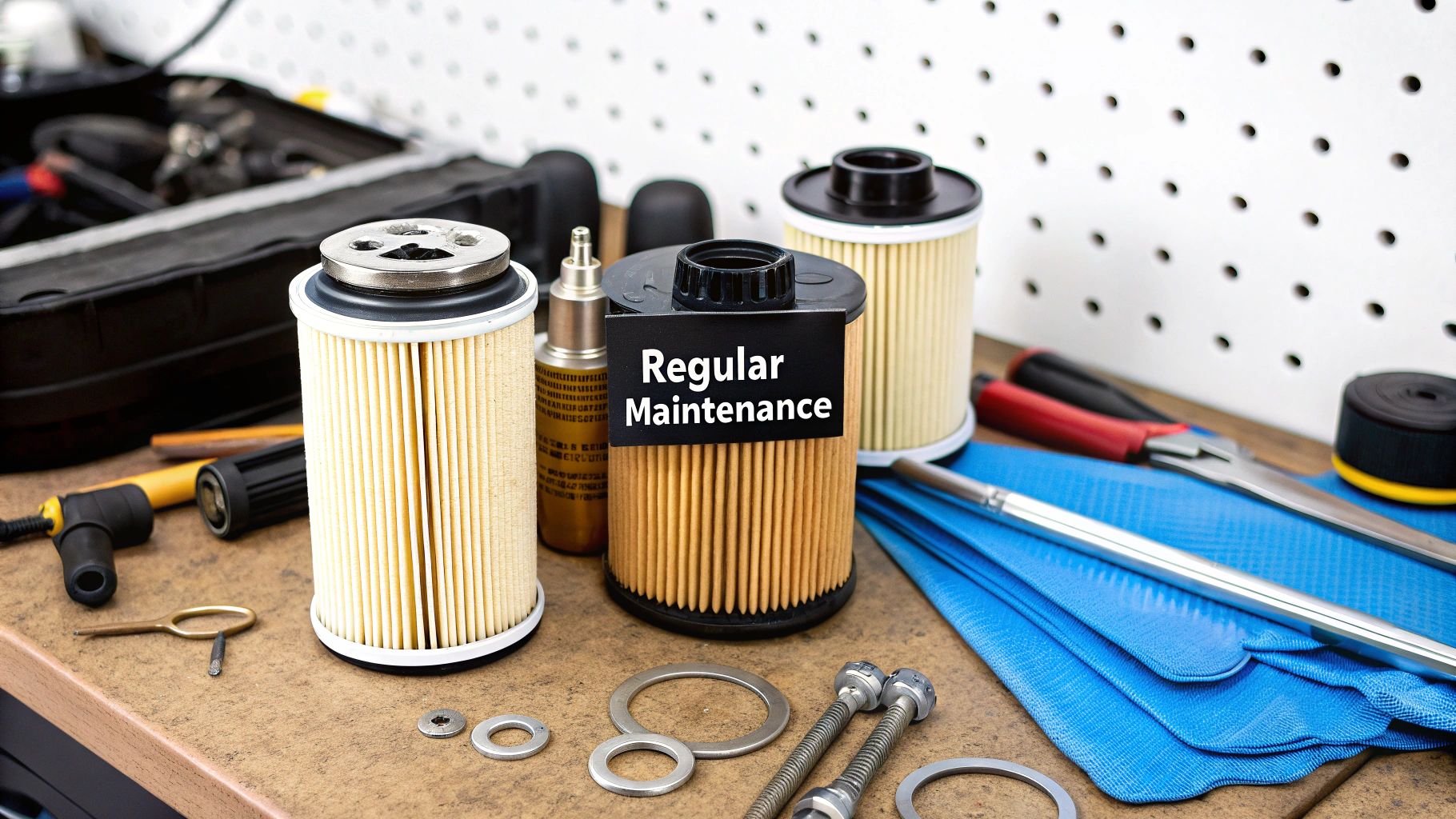
When it comes to diesel fuel filtration, you’ve got questions, and you need straight answers. We’ve cut through the technical jargon to give you practical advice you can actually use on the job site, helping you make smarter decisions about keeping your gear in top nick.
Here are the no-nonsense answers to the questions we get asked most often by operators just like you.
How Often Should I Really Change My Fuel Filters?
The golden rule is to always start with the owner’s manual. The manufacturer put that recommended service interval in there for a very good reason. That said, your real-world working conditions are what truly dictate the schedule.
Is your mini loader constantly chewing through dust on a demolition site? Or is your tracked site dumper spending its days slogging through wet, muddy paddocks? If so, you need to be far more vigilant. A good rule of thumb for tough jobs is to swap out your fuel filters with every engine oil change, unless you start noticing the tell-tale signs of clogging sooner.
Don’t ever wait for your engine to start sputtering or losing power. Think of filter changes as cheap insurance. A $50 filter change is always a better pill to swallow than a $5,000 bill for a new fuel pump and injectors.
Is It Worth Installing an Extra Fuel Filter?
In some situations, absolutely—it can be a real game-changer. But you have to be smart about it. Adding a quality pre-filter or a dedicated water separator before your main factory filter is often a brilliant upgrade.
This is especially true if your equipment lives a hard life in harsh environments. Imagine running a rock crusher in a quarry; it’s getting blasted with fine dust all day. That extra filter acts like a bodyguard, catching all the bigger chunks of debris and separating out bulk water before it gets anywhere near the important stuff. This simple addition takes a huge load off your more expensive final-stage filter, helping it last longer and giving you a much higher level of protection.
Be warned, though: just slapping on any old filter is a recipe for disaster. Adding too many filters, or one with the wrong flow rate, can actually restrict fuel supply. This starves the engine and puts a massive strain on your fuel pump, causing the exact kind of damage you were trying to prevent in the first place. Always choose an auxiliary filtration kit that’s been specifically designed for your engine’s requirements.
Can I Just Clean and Reuse My Old Fuel Filter?
In a single word: no. You should never, ever attempt to clean and reuse a disposable spin-on or cartridge-style fuel filter. It might seem like a clever way to save a few dollars, but it’s an incredibly risky gamble that could cost you an entire engine.
The filter media isn’t just a simple screen; it’s a complex web of fibres engineered to trap microscopic particles deep within its structure. Blasting it with compressed air or trying to wash it out with solvents will tear these delicate fibres to shreds.
You end up creating tiny holes, invisible to the naked eye but massive enough to let a flood of harmful grit pass straight through to your precision-engineered injectors and fuel pump. Always replace used filters with new, high-quality ones. The small cost is nothing compared to the price of rebuilding a fuel system from the ground up.
What Is the Diesel Bug and Is It a Real Problem?
Yes, it’s a very real—and very destructive—problem. The “diesel bug” isn’t an actual insect, but a catch-all term for the microbes, bacteria, and fungi that can take up residence in your fuel tank.
These nasty critters thrive at the point where water and diesel meet, which is usually right at the bottom of the tank. They feed on the hydrocarbons in the fuel and multiply like crazy, forming a thick, black, slimy gunk. This sludge is a filter’s worst nightmare and can completely choke your entire fuel system, right from the pickup tube in the tank to the filter itself.
The best ways to fight back are:
- Keep Tanks Full: Less air space in your tank means less room for water to condense. A full tank on your mini skid steer overnight is a great habit.
- Drain Water Regularly: Make draining your water separator bowl a daily habit before start-up.
- Use a Biocide: If you suspect you’ve got an infestation, you’ll need a proper biocide treatment to kill the growth, followed by a thorough tank clean to get rid of the sludge.
Staying on top of these common issues is fundamental to good machinery management. For more handy tips and in-depth guides, feel free to explore other articles on our Machtig Equipment blog.
At Machtig Mobile Equipment, we understand that reliable machinery is the backbone of your business. That’s why we supply premium European equipment and provide the end-to-end support you need to keep it performing at its peak.
Discover our range of powerful and efficient mobile equipment today.

